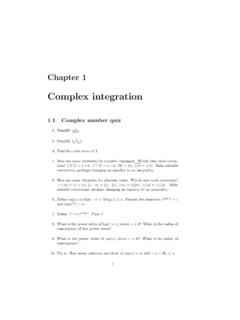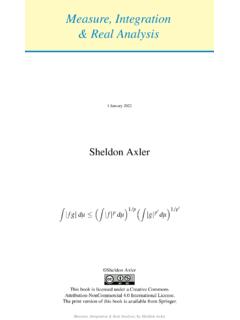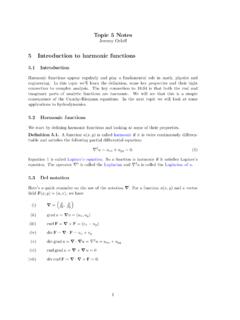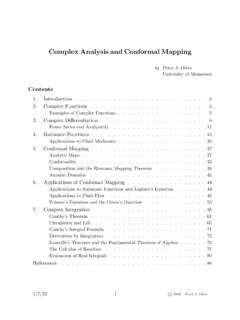Transcription of 3 Contour integrals and Cauchy’s Theorem
1 3 Contour integrals and cauchy s Line integrals of complex functionsOur goal here will be to discuss integration of complex functionsf(z) =u+iv, with particular regard to analytic functions. Of course, one way tothink of integration is as antidifferentiation. But there is also the definiteintegral. For a functionf(x) of a real variablex, we have the integral baf(x)dx. In casef(x) =u(x) +iv(x) is a complex -valued function ofa real variablex, the definite integral is the complex number obtained byintegrating the real and imaginary parts off(x) separately, baf(x)dx= bau(x)dx+i bav(x)dx.
2 For vector fieldsF= (P,Q) in the plane we havethe line integral CP dx+Qdy, whereCis an oriented curve. In casePandQare complex -valued, in which case we callP dx+Qdyacomplex1-form,we again define the line integral by integrating the real and imaginary partsseparately. Next we recall the basics of line integrals in the plane:1. The vector fieldF= (P,Q) is a gradient vector field g, which wecan write in terms of 1-forms asP dx+Qdy=dg, if and only if CP dx+Qdyonly depends on the endpoints ofC, equivalently if andonly if CP dx+Qdy= 0 for every closed curveC. IfP dx+Qdy=dg,andChas endpointsz0andz1, then we have the formula CP dx+Qdy= Cdg=g(z1) g(z0).
3 2. IfDis a plane region with oriented boundary D=C, then CP dx+Qdy= D( Q x P y) IfDis a simply connected plane region, thenF= (P,Q) is a gradientvector field gif and only ifFsatisfies the mixed partials condition Q x= P y.(Recall that a regionDissimply connectedif every simple closed curve inDis the boundary of a region contained inD. Thus a disk{z C:|z|<1}1is simply connected, whereas a ring such as{z C: 1<|z|<2}is not.)In caseP dx+Qdyis a complex 1-form, all of the above still makes sense,and in particular Green s Theorem is still will be interested in the following integrals . Letdz=dx+idy, acomplex 1-form (withP= 1 andQ=i), and letf(z) =u+iv.
4 Theexpressionf(z)dz= (u+iv)(dx+idy) = (u+iv)dx+ (iu v)dy= (udx vdy) +i(vdx+udy)is also a complex 1-form, of a very special type. Then we can define Cf(z)dzfor any reasonable closed oriented curveC. IfCis a parametrizedcurve given byr(t),a t b, then we can viewr (t) as a complex -valuedcurve, and then Cf(z)dz= baf(r(t)) r (t)dt,where the indicated multiplication is multiplication of complex numbers(andnotthe dot product). Another notation which is frequently used isthe following. We denote a parametrized curve in the complex plane byz(t),a t b, and its derivative byz (t). Then Cf(z)dz= baf(z(t))z (t) example, letCbe the curve parametrized byr(t) =t+ 2t2i, 0 t 1,and letf(z) =z2.
5 Then Cz2dz= 10(t+ 2t2i)2(1 + 4ti)dt= 10(t2 4t4+ 4t3i)(1 + 4ti)dt= 10[(t2 4t4 16t4) +i(4t3+ 4t3 16t5)]dt=t3/3 4t5+i(2t4 8t6/3)]10= 11/3 + ( 2/3) another example, let letCbe the unit circle, which can be efficientlyparametrized asr(t) =eit= cost+isint, 0 t 2 , and letf(z) = (t) = sint+icost=i(cost+isint) = that this is what we would get by the usual calculation ofddteit. Then C z dz= 2 0eit ieitdt= 2 0e it ieitdt= 2 0idt= 2 final point in this section: letf(z) =u+ivbe any complex valuedfunction. Then we can compute f, or equivalentlydf. This computationis important, among other reasons, because of the chain rule: ifr(t) =(x(t),y(t)) is a parametrized curve in the plane, thenddtf(r(t)) = f r (t) = f xdxdt+ f ydydt.
6 (Here means the dot product.) We can think of obtainingddtf(r(t)) roughlyby taking the formal definitiondf= f xdx+ f ydyand dividing both course we expect thatdfshould have a particularly nice form iff(z)is analytic. In fact, for a general functionf(z) =u+iv, we havedf=( u x+i v x)dx+( u y+i v y)dyand thus, iff(z) is analytic,df=( u x+i v x)dx+( v x+i u x)dy=( u x+i v x)dx+( u x+i v x)idy=( u x+i v x)(dx+idy) =f (z) : iff(z) is analytic, thendf=f (z)dzand thus, ifz(t) = (x(t),y(t)) is a parametrized curve, thenddtf(z(t)) =f (z(t))z (t)This is sometimes called thechain rule for analytic functions. For example,if =a+biis a complex number, then applying the chain rule to theanalytic functionf(z) =ezandz(t) = t=at+ (bt)i, we see thatddte t= e cauchy s theoremSuppose now thatCis a simple closed curve which is the boundary Dof aregion inC.
7 We want to apply Green s Theorem to the integral Cf(z) this out, sincef(z)dz= (u+iv)(dx+idy) = (udx v dy) +i(v dx+udy),we see that Cf(z)dz= D( v x u y)dA+i D( u x v y) , the integrand is always zero if and only if the following equations hold: v x= u y; u x= v course, these are just the cauchy -Riemann equations! This gives: Theorem ( cauchy s integral Theorem ): LetCbe a simple closed curvewhich is the boundary Dof a region inC. Letf(z) be analytic inD. Then Cf(z)dz= , there is a stronger result, which we shall prove in the nextsection: Theorem ( cauchy s integral Theorem 2): LetDbe a simply connectedregion inCand letCbe a closed curve (not necessarily simple) containedinD.
8 Letf(z) be analytic inD. Then Cf(z)dz= : letD=Cand letf(z) be the functionz2+z+ 1. LetCbethe unit circle. Then as before we use the parametrization of the unit circlegiven byr(t) =eit, 0 t 2 , andr (t) =ieit. Thus Cf(z)dz= 2 0(e2it+eit+ 1)ieitdt=i 2 0(e3it+e2it+eit) is easy to check directly that this integral is 0, for example because termssuch as 2 0cos 3tdt(or the same integral with cos 3treplaced by sin 3torcos 2t, etc.) are all the other hand, again withCthe unit circle, C1zdz= 2 0e itieitdt=i 2 0dt= 2 i6= difference is that 1/zis analytic in the regionC {0}={z C:z6= 0},but this region is not simply connected.
9 (Why not?)Actually, the converse to cauchy s Theorem is also true: if Cf(z)dz= 0for every closed curve in a regionD(simply connected or not), thenf(z) isanalytic inD. We will see this AntiderivativesIfDis a simply connected region,Cis a curve contained inD,P,Qare de-fined inDand Q x= P y, then the line integral CP dx+Qdyonly dependson the endpoints ofC. However, ifP dx+Qdy=dF, then CP dx+Qdyonly depends on the endpoints ofCwhether or notDis simply see what this condition means in terms of complex function theory: Letf(z) =u+ivand suppose thatf(z)dz=dF, where we writeFin terms ofits real and imaginary parts asF=U+iV.
10 This says that(udx v dy) +i(v dx+udy) =( U xdx+ U ydy)+i( V xdx+ V ydy).Equating terms, this says thatu= U x= V yv= U y= V particular, we see thatFsatisfies the cauchy -Riemann equations, andits complex derivative isF (z) = U x+i V x=u+iv=f(z).5We say thatF(z) is acomplex antiderivativeforf(z), (z) =f(z). Inthis case u x= 2U x2= 2V x y= v y; u y= 2U y2= 2V x y= v follows that, iff(z) has a complex antiderivative, thenf(z) satisfies theCauchy-Riemann equations:f(z) is necessarily we see: Theorem : If the 1-formf(z)dzis of the formdF, or equivalently thevector field (u+iv, v+iu) is a gradient vector field (U+iV), then bothF(z) andf(z) are analytic, andF(z) is a complex antiderivative forf(z):F (z) =f(z).













